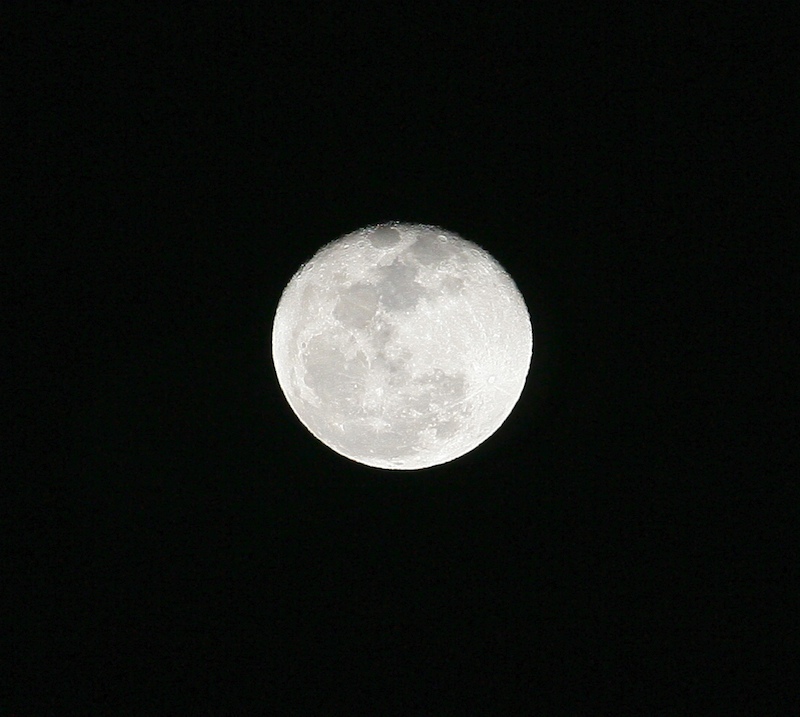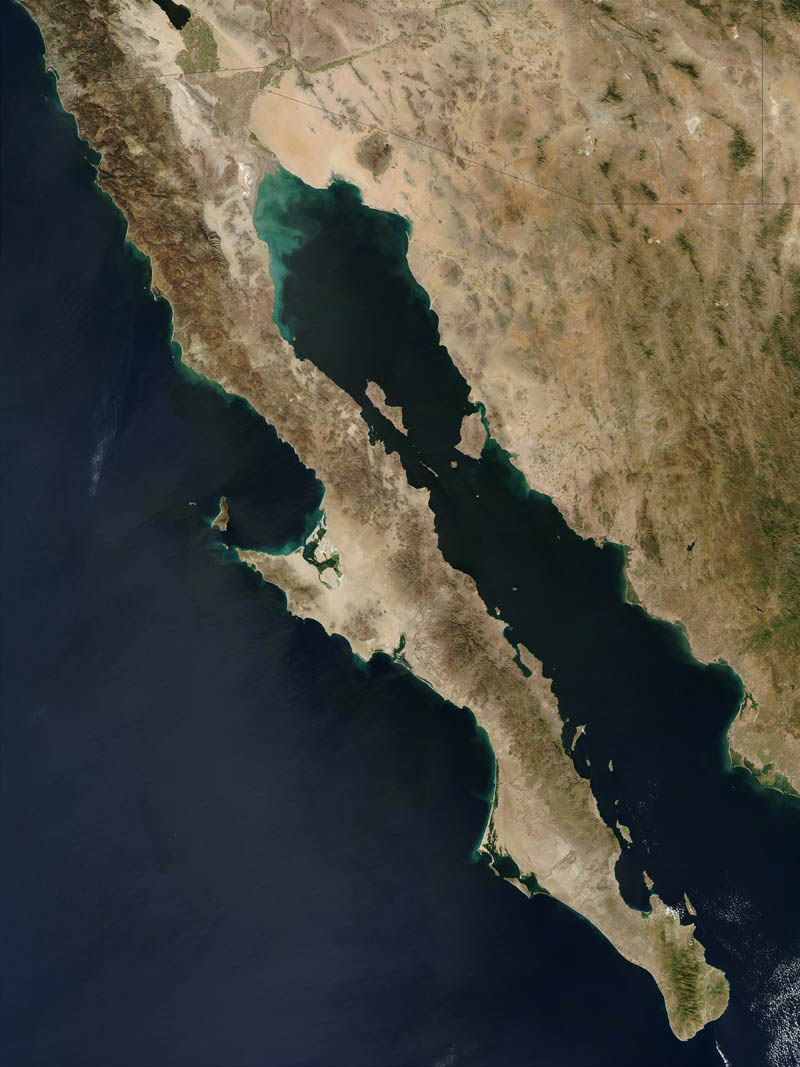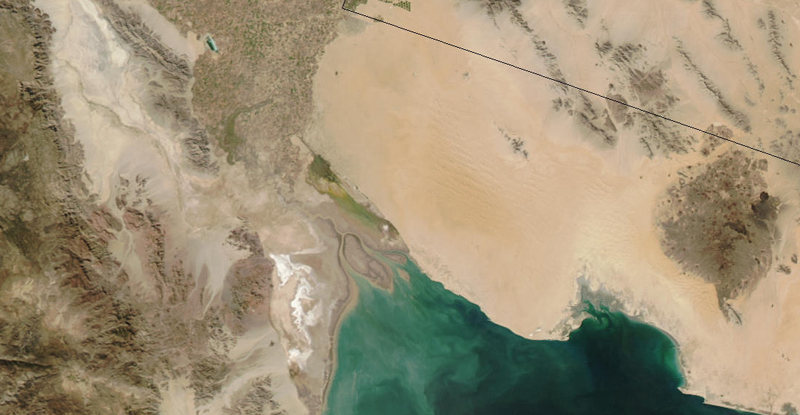El Golfo and Guadalupe Canyon Adventure
Full closure on an anniversary, plus a bunch of fun
20080221 to 20080224
Back to Bill Caid's Home Page.

El Golfo beach serves up clear air and a full moon.
Canon 1DsM2, 300mm, 1/420 at f/7.1 ISO 100. All photos copyright, Bill Caid 2008. All rights reserved.
A Wonderful Trip with Closure
Northwestern Sonora in Mexico is one of the largest remaining remote areas south of Canada. This area is hard core desert, cruel in the summer and unforgiving of mistakes. Four wheel drive clubs in the southwest have been making crossings of the Altar Dunes from Sonoyta and San Luis del Colorado for many years. This vast area offers one of the last remaining true adventures within easy driving distance from the US. This group has done this trip in 2000, 2002, 2003, 2004, 2005, 2007 with nearly the same crew, so we had good knowledge of the rigors that faced us. Indeed, any trip to back country Mexico is a test of man and machine as well as your logistical planning skills. This trip would be somewhat different for a number of reasons. First, we had only a limited contingent of folks due to various reasons. Second, this trip was the first anniversary of the passing of my buddy Kai's father, Rogelio, in 2007. Since that previous trip where his ashes were scattered among the dunes of the upper Sea of Cortez, all remaining actions of his estate have been completed. This trip celebrated that completion and provided full closure.
The Team
The away team for this trip consisted of 3 vehicles but only 4 (reasonably) seasoned travelers. Several of our "regulars" could not make this trip due to work and/or family obligations. This group consisted of:
-
Bill and Kathleen from San Diego, CA in Bill's turbo charged 1300L with "new" Alaskan Camper
-
Kai from San Diego, CA in Kai's Unimog 416
-
Randy Lester in Randy's normally aspirated ex-German 1300L
The Trip
Our trip to Mexico involved only 4 days and around 400 miles of travel. We crossed the border at Mexicali and drove south on MX Hwy 5 to BCN Hwy 4, then east through the delta of the Colorado River. From there, we intersected SON Hwy 40 and headed south to El Golfo. From El Golfo, we headed east along the beach to our planned camp close to the salt mines. We stayed at the beach for 2 nights, then returned to El Golfo via the beach route and from there retraced our route back to MX Hwy 2. We took Hwy 2 west to Laguna Salada, then south to Guadalupe Canyon. From Guadalupe, we would return to the U.S. on Hwy 2 and cross the border at Tecate.
There were several storms that dogged us during this trip, but gladly, the winds were not overly strong and the temperatures were moderate.
Geography of the Altar Desert
Unlike previous trips, we were not heading into the high dunes of the Altar Desert, but rather taking the "easy route" along the beach east of El Golfo. Figure 1 shows a satellite photo of the entire Baja peninsula. Figure 2 below shows a zoom of the area of operations for this trip. True north in these photos is about 30 degrees to the right of the left border.
In Figure 1, San Diego bay is just below the top edge on the left. The large lake is the Salton Sea. Farmed areas are shown in darker colors. Click on the photo for a higher-resolution photo.
Figure 1. Satellite Photo of Baja and Northwest Sonora, Mexico.
In Figure 2, the large dunes are evident and can be seen as forming a set that roughly parallel the coast to the south. We would end up at Guadalupe Canyon which is the northern-most large canyon area on the mountain front on the left of Figure 2.
Figure 2. Zoom Photograph of Area of Interest.
Trip Details
| Day | Date | Adventure |
|---|---|---|
1&2 |
20080221 |
San Diego to El Golfo Beach Camp |
3 |
20080223 |
El Golfo to Canyon de Guadalupe |
4 |
20080224 |
Canyon de Guadalupe & Return to San Diego |
Conclusion
El Gulfo is a very small town; it is primarily a fishing village, but does cater to tourists, particularly Gringos around Thanksgiving, Christmas and New Years. There is a Pemex station, and it might have gas and diesel. I say "might", because in Mexico, if the fuel truck does not show up for what ever reason, then there will be no gas or diesel. On this trip, there was sufficient diesel for the entire group. On the previous trip, the Pemex station was under repair due to leaking tanks and therefore the next diesel would me available in a month or so depending on the motivation of the workers. El Gulfo has a store and ice is available along with plenty of fresh fish, shrimp, clams and sometimes other shellfish. Water is in short supply, but can be purchased at the town OXXO store. There are several RV parks in town and several "hotels". The quotes are used here since one of the selling features of the hotel is that it has indoor plumbing. But, we noted that with the completion of the western end of the new highway that connects El Golfo with Puerto Penasco to the east, there were several new more modern hotels under construction. The "old" El Golfo will soon be gone.
The locals make their living as fishermen and good seafood is available at all times. The best restaurant in El Gulfo is the El Delfin and has excellent food although modest accommodations (they did, however, have hot water in the washroom and fully functional toilets).
Traveler's Advice
Having made many trips into Mexico, every one is different and this one was no exception. Preparation and planning are critical for both having a good time as well as returning with your vehicle and person intact. Many obstacles exist on the roads in Mexico. I cannot count the number of flats that I have had, but I can say that there have been multiple occasions when I have had 2 flats at the same time. So, you need to be prepared to change flats yourself. Even if you were in an area where there was cell phone service, and that is rare, the auto club will offer no help. And, as we learned, your cell phone may not work in Mexico. Be self sufficient. And be cautious. Roads and bridges are narrow. Cattle and other livestock are on the road. Locals may drive vehicles without brake lights, or in some cases headlights, at night.
You will need liability insurance when you cross the border. It is not expensive, but the cost of not having it if you are in an accident will be very expensive. They will toss you in jail and the final outcome will be dependent on how much money you are willing to throw at the problem. Independent of insurance, accidents are best avoided, so drive within the limits of your skill and the conditions on the road. Seems like simple advice, but having been there many times, sometimes simple advice is not simple.
One final note: you will need both a Plan B and an evacuation contingency should someone get sick or injured. Depending on the specific location, you may have extreme difficulty in establishing contact with the US with either land lines or cell phones. Our cell phones, while electronically functional, had spotty coverage and the specific capabilities of your phone and service plan will determine whether you are able to make a call. Should you expect that there might be issues during your trip, you should add Mexico to your calling plan or rent a satellite phone. Otherwise, you may be unpleasantly surprised should you need to communicate.
Miscellaneous Information
Firearms are prohibited in Mexico. Handguns, in particular, are frowned upon. If you are caught with one in your possession, you will go directly to jail. There is a very high likelihood that you will be unable to "buy" your way out of the situation no matter how much money you have with you, so this situation is better avoided. While lack of a firearm in the wilderness will place you at somewhat of a disadvantage should trouble arise, the penalty for possession is so harsh that it is not worth the risk. Northern Sonora and Baja are area of operations known to be used by drug smugglers. However, open desert crossings are not the preferred route, so the chance of encountering anyone is pretty remote. Although, we have had the Army follow us into the dunes. The Mexican Army does patrol both the north end and the sea-side of the desert as well as the dry lake beds and if they stop you, they will most likely do a thorough search of the vehicle. They pose no threat to honest Gringos that do not break the laws of their country.
Back to Bill Caid's Home Page.
Copyright Bill Caid 2008

